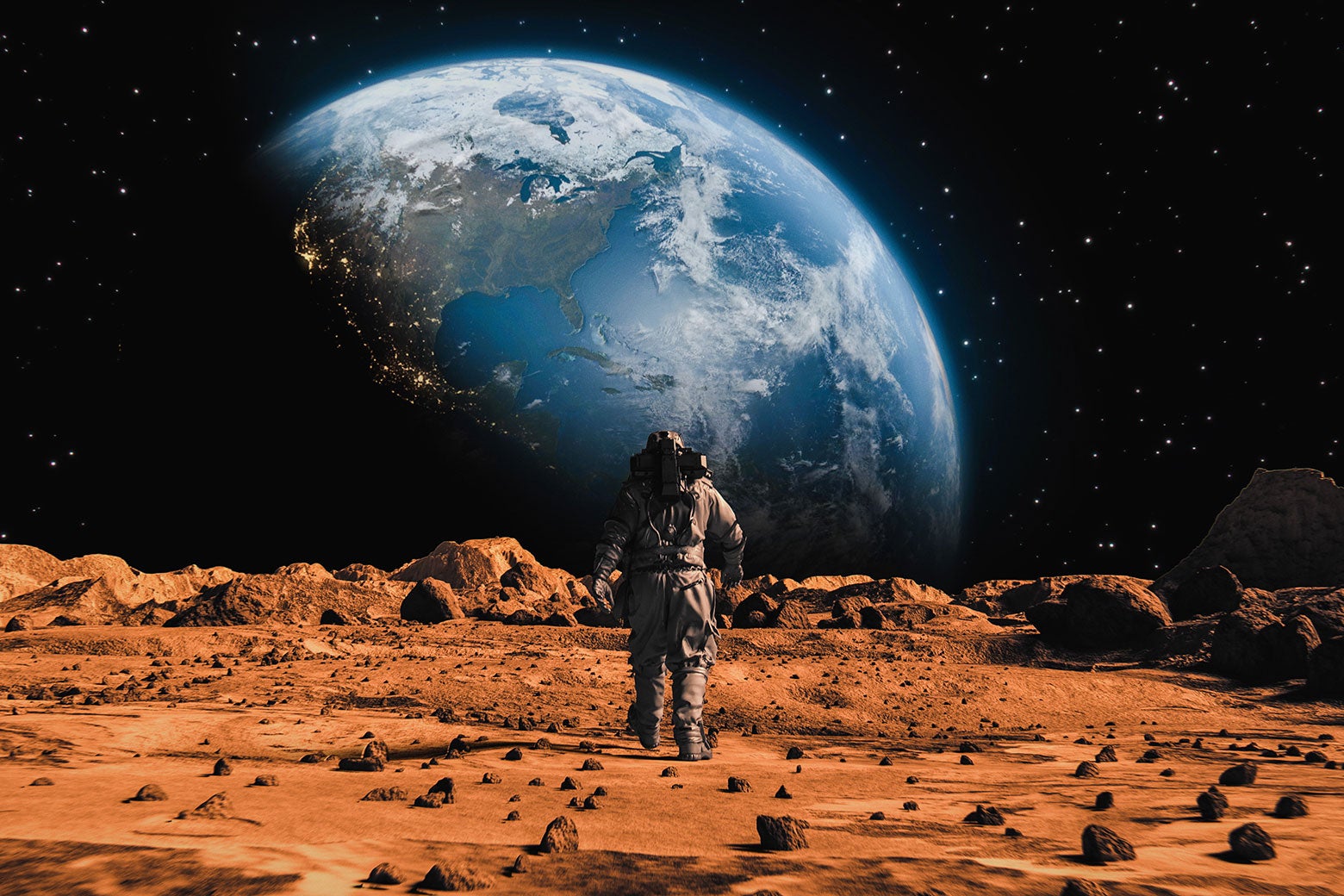Slate has relationships with various online retailers. If you buy something through our links, Slate may earn an affiliate commission. We update links when possible, but note that deals can expire and all prices are subject to change. All prices were up to date at the time of publication.
Adapted from The End of Astronauts: Why Robots Are the Future of Exploration by Donald Goldsmith and Martin Rees, published by the Belknap Press of Harvard University Press.
In the last 60 years, half a dozen spacecraft have flown past Mars, and 15 others have orbited the planet; seven have landed on Mars, and six rovers have traversed part of the Martian surface. Nearly two dozen spacecraft destined for Mars have failed in their efforts, some on the launch pad, some in interplanetary space, and some on the Martian surface. The first Martian fly-by (1964), the first Martian orbiter (1971), the first Martian landers (1976), and the first Martian rover (1996) testify to our stubbornness and problem-solving abilities in overcoming the obstacles to exploring another planet.
These successes may tend to obscure the most significant obstacle of missions to Mars, especially those that require providing life support to astronauts for months on end: It’s a long way to the Red Planet. As Mars and Earth orbit the sun, the distance between them varies by a factor of seven, from 35 million miles at their closest up to 250 million miles at their most distant. Reworking a simile provided by John McPhee, if you imagine the Earth-moon distance as a short fingernail clipping, the least Earth-Mars distance will run to your elbow, while the longest will span twice the width of your outstretched arms. The laws of gravity and planetary dynamics disfavor trips across the shortest path; instead, interplanetary travel to Mars typically covers 300 million miles, even more than the greatest distance to Mars, as the spacecraft swoops outward to overtake the planet. Using our best rocket technology, each journey requires nearly seven months.
The advantages that human explorers now hold over robots will continue to diminish as advances in A.I. and technology increase the robots’ abilities. Future breakthroughs in artificial intelligence could lead to self-guided Martian robots that would follow general instructions while performing the same tasks that human explorers would. We may use the Perseverance rover’s success on Mars to analyze the issue of how astronauts on Mars would improve the situation. What would change if we replaced a fully automated investigation with one with on-site humans? To take sample return as an example, the tasks involved include reaching Mars, choosing the best locations to sample, drilling into the rocks or soil at those locations, extracting material and sealing it for study, bringing the material to Earth, and examining the samples with the instruments best suited to that task. For all of these except the choice of drilling locations, robots rather than humans can perform more safely, more easily, and less expensively. They cannot match the brain of an experienced geologist—for now. Although our robots will continue to increase their artificial intelligence, no one knows when, if ever, they can match us humans, though we must beware of a bias in assessing our own proficiency.
For some people the idea of having humans on the ground provides the paramount reason for space exploration. In that context, the history of our efforts to study Mars appears as a 60-year prelude to the epoch when humans reach Mars and colonize it. Marvelous though this era will be, the issue remains not whether we want it as soon as possible but whether we need it as soon as possible. Consider this heartfelt exclamation from Jeffrey Hoffman, one of the scientist-astronauts who repaired the Hubble Space Telescope. After five missions in space, Hoffman has no hesitation in saying, “I want to know what it’s like being on Mars!” For those of us who are not going there, the desire to put humans on Mars resides not in our own journey but in relishing the views and news from those who do reach the planet. Hoffman himself summarizes the robot/human issue by saying, “If it can be done robotically, do it.”
The scientific rationale for sending astronauts to Mars centers on the expectation that the long experience and human flexibility of scientifically trained astronauts will allow them to search through new locales and to discern special, perhaps unexpected features far more rapidly than any robot can. Steve Swanson, who flew twice on the space shuttle and once to the International Space Station, points to the fact that Apollo 17’s astronauts covered 22 miles on the moon in three days, while the Curiosity rover on Mars traveled about 12 miles in more than six years. Quite so—but Perseverance will cover Martian ground far more rapidly, and its successors will do still better. The same objection applies to the statement that Steve Squyres, one of the chief scientists for Curiosity’s predecessors, Spirit and Opportunity, made in 2005: “The unfortunate truth is that most things our rovers can do in a perfect sol [one Martian day of 24 hours and 37 minutes], a human explorer on the scene could do in less than a minute.” In 2009, Squyres left academia to become the chief scientist at Jeff Bezos’ Blue Origin corporation, which plans to land cargo on the moon by 2023 and astronauts a year later.
Chris McKay, one of the leading astrobiologists involved in planning future missions to Mars, has spent years in the Arctic and Antarctic to study life under conditions as close to those on Mars as Earth offers. When will robots on Mars have abilities equal to those of a human field scientist? Not on the horizon, McKay says. What about abilities equal to those of a capable field assistant? That would require our robots’ current capabilities to be doubled at least five times, he thinks; he notes that at present each doubling requires more than a decade, “but innovations in the space biz may greatly shorten that.”
Those who want to make the strongest scientific case for astronauts on Mars should rely on McKay’s judgment to argue that in order to obtain the best result, we must send our best investigators: humans. The issue then becomes one of how much we are willing to pay for the advantages that humans can provide. Those who favor robots could stress that as more time elapses, the advantage humans hold over robots will continue to decline, eventually to the point that the scientific argument for astronauts disappears. Meanwhile, public enthusiasm for sending astronauts to Mars will persist, not so much because of the superiority of human geologists but instead because of the belief that we ought to go there.
How badly do we want to see humans on Mars? If you want to assess the strength of your own desire, try the following approach. Imagine that advances in technology could produce a superior form of virtual reality that would allow you to transport your senses to Mars, so that you could feel yourself walking on its surface, feeling the light Martian breezes, watching the sun set over Olympus Mons or Tharsis Tholus, or admiring temporary rivulets at the edge of the ice cap at the South Pole. How less satisfactory would this be than traveling to Mars in your actual body? And how much more important would it be for astronauts to reach Mars in person rather than by this advanced application of virtual exploration? If you believe that in-person exploration could reveal more than virtual exploration, you have judged that we need astronauts. But if you believe that we’re not really exploring Mars if we only do it virtually, then your stance reflects primarily your desire to see them on Mars.
The End of Astronauts: Why Robots Are the Future of Exploration
By Donald Goldsmith and Martin Rees. Belknap Press.
Honesty compels us to admit that this type of virtual reality probably could never occur, not least because of the many minutes required for any transmission between Earth and Mars. But try the mental experiment not with Mars but with Mount Everest: How different would it be for you to experience everything that a climber does without being physically present on the mountain?
“Mars ain’t the kind of place to raise your kids,” Elton John famously sang in his song “Rocket Man.” A lot of people who want to see human settlement on our neighbor planet think he’s wrong. And yes, exploring Mars—understanding its geology, searching for traces of ancient life and for possible existing life in places where liquid water exists, uncovering Mars’s history and how it fits into the origin and evolution of the solar system, flying drones that can map the entire surface of the planet and discover individual locations of intense interest—is a marvelous goal that fascinates all of us. But to achieve this, we don’t need astronauts, whose presence inevitably degrades their surroundings—something that is of special concern if we hope to be sure that any life forms we may discover are indeed Martian. When we send our ever-improved robots there, they confirm that we are indeed on Mars—not individual humans, but all of us, the earthly species that has the ability to explore another planet in an efficient and ecologically sound manner.
Future Tense is a partnership of Slate, New America, and Arizona State University that examines emerging technologies, public policy, and society.

